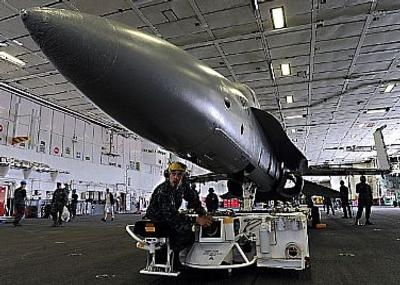Wed, Sep 18, 2013
Program Consisted Of 160 Total Carrier Landings In Day And Night Conditions
USS Theodore Roosevelt (CVN 71) and Carrier Air Wing (CVW) 1, successfully completed flight deck certification, Sept. 14, fulfilling an important milestone of getting the ship and its embarked airwing combat ready. The Red Rippers of Fighter Attack Squadron (VFA) 11, Knighthawks of VFA 136, Checkmates of VFA 211, Screwtops of Carrier Early Warning Squadron (VAW) 123, and Dragonslayers of Helicopter Anti-submarine Squadron (HS) 11 all took part in the certification, and were instrumental in the success and safety of the flight operations.

The flight deck certification consisted of 160 total carrier landings, during both the day and night. Certification drills included rigging the emergency barricade, flight deck firefighting and crash and salvage operations. "We worked hard to make sure that all expectations were met," said Chief Aviation Boatswain's Mate (Handling) Frank E. Gardner, flight deck leading chief petty officer. "We out performed what was expected of us."
This is a monumental achievement for Theodore Roosevelt since it is the first time it has landed aircraft on its deck in four years. "It's amazing to see so many Sailors who have never seen a deployment come together to accomplish this task," said Aviation Boatswain's Mate (Handling) 1st Class Terry Keyes. "It took a lot of work and long days to get things done and accomplished, but the end result was more than what we expected."
Before the flight deck crew left the shipyard, they spent many hours training on all aspects of how the flight deck operates under all conditions. "We spent long hours training our crew," said Gardner. "We wanted to make sure that everything could go as smoothly as we could possibly make it."
Time management and teamwork were both keys to the success of the flight deck certification process. "We have to manage our time while on station," said Aviation Boatswain's Mate (Handling) 1st Class Raymond Gross, leading petty officer of fly two, a division of Air department. "We have to work with other sections of Air Department to be able to take breaks and get food because our job requires us to be on deck when jets are moving about."

Keyes added that flexibility was also important in the event of last minute changes, such as catapult repairs or aircraft reorganization for launch. "No matter how well we worked together, we had to remain flexible because anything could happen," said Keyes. "Equipment may go down or a jet may need fuel, so we had to constantly make changes in a safe but efficient manner."
The success of flight deck certification marks one step closer for Theodore Roosevelt to becoming, once again, a ready-for-tasking carrier. Theodore Roosevelt will continue carrier qualifications during the current underway period.
(Images provided by the U.S. Navy)
ANN Salutes Mass Communication Specialist 3rd Class Heath Zeigler, USS Theodore Roosevelt Public Affairs
More News
From 2023 (YouTube Edition): An Even Faster Rolling Extra! Jim Campbell joined General Manager of Extra Aircraft Duncan Koerbel at AirVenture 2023 to talk about what’s up and>[...]
“Receiving our Permit to Fly and starting Phase 4 marks a defining moment for Vertical Aerospace. Our team has spent months verifying every core system under close regulatory>[...]
Middle Marker A marker beacon that defines a point along the glideslope of an ILS normally located at or near the point of decision height (ILS Category I). It is keyed to transmit>[...]
The Experienced Pilot Chose To Operate In Instrument Meteorological Conditions Without An Instrument Flight Rules Clearance Analysis: The airplane was operated on a personal cross->[...]
Also: ATI Strike Prep, Spirit Still Troubled, New CubCrafters Dealership, A-29 Super Tucano Samaritan’s Purse is officially moving its historic Douglas DC-8 cargo jet into re>[...]
 Classic Aero-TV: Extra Aircraft Announces the Extra 330SX
Classic Aero-TV: Extra Aircraft Announces the Extra 330SX Aero-News: Quote of the Day (11.15.25)
Aero-News: Quote of the Day (11.15.25) ANN's Daily Aero-Term (11.15.25): Middle Marker
ANN's Daily Aero-Term (11.15.25): Middle Marker NTSB Final Report: Lancair 320
NTSB Final Report: Lancair 320 Airborne 11.14.25: Last DC-8 Retires, Boeing Recovery, Teeny Trig TXP
Airborne 11.14.25: Last DC-8 Retires, Boeing Recovery, Teeny Trig TXP




